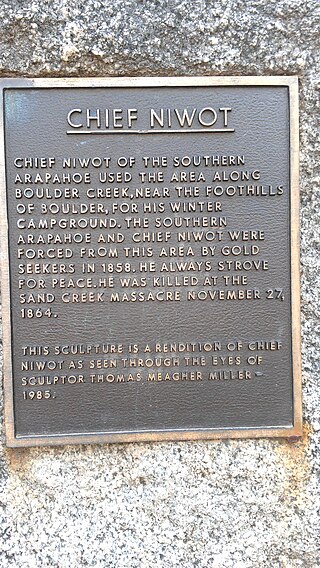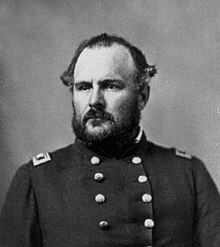
The Arapaho are a Native American people historically living on the plains of Colorado and Wyoming. They were close allies of the Cheyenne tribe and loosely aligned with the Lakota and Dakota.

The Sand Creek massacre was a massacre of Cheyenne and Arapaho people by the U.S. Army in the American Indian Wars that occurred on November 29, 1864, when a 675-man force of the Third Colorado Cavalry under the command of U.S. Volunteers Colonel John Chivington attacked and destroyed a village of Cheyenne and Arapaho people in southeastern Colorado Territory, killing and mutilating an estimated 69 to over 600 Native American people. Chivington claimed 500 to 600 warriors were killed. However, most sources estimate around 150 people were killed, about two-thirds of whom were women and children. The location has been designated the Sand Creek Massacre National Historic Site and is administered by the National Park Service. The massacre is considered part of a series of events known as the Colorado Wars.

John Milton Chivington was an American criminal, Methodist pastor, and Mason who served as a colonel in the United States Volunteers during the New Mexico Campaign of the American Civil War. He led a rear action against a Confederate supply train in the Battle of Glorieta Pass, and was then appointed a colonel of cavalry during the Colorado War.

Black Kettle was a prominent leader of the Southern Cheyenne during the American Indian Wars. Born to the Northern Só'taeo'o / Só'taétaneo'o band of the Northern Cheyenne in the Black Hills of present-day South Dakota, he later married into the Wotápio / Wutapai band of the Southern Cheyenne.

The Sioux Wars were a series of conflicts between the United States and various subgroups of the Sioux people which occurred in the later half of the 19th century. The earliest conflict came in 1854 when a fight broke out at Fort Laramie in Wyoming, when Sioux warriors killed 31 American soldiers in the Grattan Massacre, and the final came in 1890 during the Ghost Dance War.

John Evans was an American politician, physician, founder of various hospitals and medical associations, railroad promoter, governor of the territory of Colorado, and namesake of Evanston, Illinois; Evans, Colorado; and Mount Evans, Colorado.

The Colorado War was an Indian War fought in 1864 and 1865 between the Southern Cheyenne, Arapaho, and allied Brulé and Oglala Sioux peoples versus the U.S. Army, Colorado militia, and white settlers in Colorado Territory and adjacent regions. The Kiowa and the Comanche played a minor role in actions that occurred in the southern part of the Territory along the Arkansas River. The Cheyenne, Arapaho, and Sioux played the major role in actions that occurred north of the Arkansas River and along the South Platte River, the Great Platte River Road, and the eastern portion of the Overland Trail. The United States government and Colorado Territory authorities participated through the 1st Colorado Cavalry Regiment, often called the Colorado volunteers. The war was centered on the Colorado Eastern Plains, extending eastward into Kansas and Nebraska.

The 1st Colorado Cavalry Regiment was formed in November 1862 by Territorial Governor John Evans, composed mostly of members of the 1st Colorado Infantry Regiment and of C and D Companies of the 2nd Colorado Infantry Regiment. It was formed both to protect Colorado against incursions from the Confederate forces and to fight the Native Americans who already inhabited the area.

Samuel Forster Tappan was an American journalist, military officer, abolitionist and a Native American rights activist. Appointed as a member of the Indian Peace Commission in 1867 to reach peace with the Plains Indians, he advocated self-determination for native tribes. He proposed the federal government replace military jurisdiction over tribal matters with a form of civil law on reservations, applied by the tribes themselves.

The Colorado Territory was formally created in 1861 shortly before the bombardment of Fort Sumter sparked the American Civil War. Although sentiments were somewhat divided in the early days of the war, Colorado was only marginally a pro-Union territory. Colorado was strategically important to both the Union and Confederacy because of the gold and silver mines there as both sides wanted to use the mineral wealth to help finance the war. The New Mexico Campaign was a military operation conducted by Confederate Brigadier General Henry Sibley to gain control of the Southwest, including the gold fields of Colorado, the mineral-rich territory of Nevada and the ports of California. The campaign was intended as a prelude to an invasion of the Colorado Territory and an attempt to cut the supply lines between California and the rest of the Union. However, the Confederates were defeated at the Battle of Glorieta Pass in New Mexico and were forced to retreat back to Texas, effectively ending the New Mexico Campaign.
The Treaty of Fort Wise of 1861 was a treaty entered into between the United States and six chiefs of the Southern Cheyenne and four of the Southern Arapaho Indian tribes. A significant proportion of Cheyennes opposed this treaty on the grounds that only a minority of Cheyenne chiefs had signed, and without the consent or approval of the rest of the tribe. Different responses to the treaty became a source of conflict between whites and Indians, leading to the Colorado War of 1864, including the Sand Creek Massacre.
Little Rock was a council chief of the Wutapiu band of Southern Cheyennes. He was the only council chief who remained with Black Kettle following the Sand Creek massacre of 1864.

Edward Wanshear Wynkoop was a US Army officer during the American Civil War and later an Indian agent. He was a founder of the city of Denver, Colorado. Wynkoop Street in Denver is named after him.

Chief Niwot or Left Hand(-ed) was a Southern Arapaho chief, diplomat, and interpreter who negotiated for peace between white settlers and the Cheyenne and Arapaho tribes during the Pike's Peak Gold Rush and Colorado War.

George Bent, also named Ho—my-ike in Cheyenne, was a Cheyenne-Anglo who became a Confederate soldier during the American Civil War and waged war against Americans as a Cheyenne warrior afterward. He was the mixed-race son of Owl Woman, daughter of a Cheyenne chief, and the American William Bent, founder of the trading post named Bent's Fort and a trading partnership with his brothers and Ceran St. Vrain. Bent was born near present-day La Junta, Colorado, and was reared among both his mother's people, his father and other European Americans at the fort, and other whites from the age of 10 while attending boarding school in St. Louis, Missouri. He identified as Cheyenne.

Howling Wolf was a Southern Cheyenne warrior who was a member of Black Kettle's band and was present at the Sand Creek Massacre in Colorado. After being imprisoned in the Fort Marion in Saint Augustine, Florida in 1875, Howling Wolf became a proficient artist in a style known as Ledger art for the accounting ledger books in which the drawings were done.
The Hungate massacre involved the murder of the family of Nathan Hungate along Running Creek on June 11, 1864. It was a precipitating factor leading to the Sand Creek massacre of November 29, 1864.

Fort Weld, also called Camp Weld, began as a military camp on 30 acres east of the Platte River in what is now the La Alma-Lincoln Park neighborhood of Denver, Colorado. It was named for Lewis Ledyard Weld, the first Territorial Secretary. The central square of the post was used to practice drills of the troops. Buildings—soldier's quarters, officers' headquarters, mess rooms, a hospital, and a guard house—surrounded the square. The main entrance to the camp was on the eastern side of the post. It was established on September 1861 and abandoned in 1865.

Ochinee, also known as Lone Bear and One-Eye, was a Native American Peace Chief of the Cheyenne tribe. He was the father of Amache Prowers, a tradeswoman, advocate and leader among the Southern Cheyenne. Ochinee, who had worked to create peace for the Cheyenne, died during the Sand Creek massacre on November 29, 1864.

White Antelope was a chief of the Southern Cheyenne. He was known for his advocacy of peace between white Americans living in the Great Plains until his killing at the Sand Creek massacre. Accounts of the massacre conflict as to whether White Antelope led his people in resistance to the attack or continued to advocate for peace until his death. White Antelope's body was desecrated after the massacre, and the blanket he was wearing stolen.


















